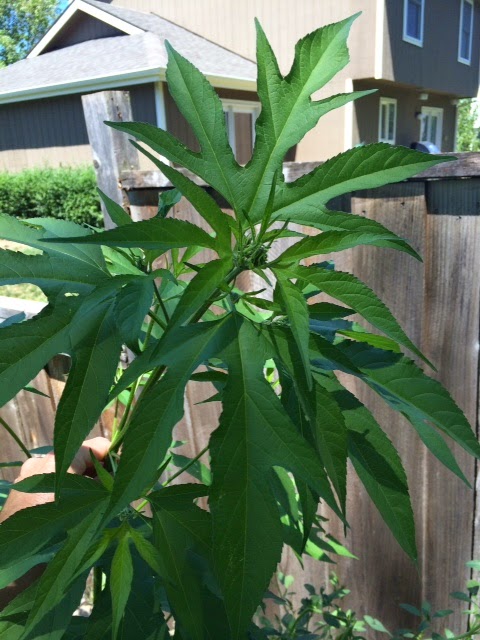Ragweed! A Common Kansas Weed
2. Fernlike mature leaves.
3 . Stems are usually covered with velvety hairs.
Male and female flowers of common ragweed are in separate flower
heads on the same plant (monoecious habit). The female flower heads are
green, stemless, and inconspicuous. They are borne singly or in small
clusters in the crooks (axils) of the upper leaves. The male heads are
more clustered; 10 to 100 flowers are arranged in tight spikes at the
tops of stems and branches. Common ragweed flowers in August and early
September, producing huge amounts of dry dusty pollen
that is dispersed mainly by wind. . Seed production begins in late August and
continues through September. Although each female flower produces only
one seed, a plant that emerges in mid-May can easily have 30,000 to
62,000 seeds. Seeds are dispersed by water (through rain-wash channels
or gulleys), birds, burrowing animals, and humans. During summer and
fall, wind plays a minor role in dispersal, but in winter it may roll
the seeds for long distances over the surface of crusted snow.3 . Stems are usually covered with velvety hairs.
5. Common ragweed (right) and giant ragweed (left).
Common ragweed is extremely competitive, partly because it can accumulate large quantities of trace elements. Corn studies show that common ragweed generally absorbs much more boron, copper, magnesium, zinc, tin, galium, vanadium, bismuth, nickel, chromium, potassium, and calcium than do com leaves harvested at tassel stage. Ragweed grows well on soils containing enough zinc to be toxic to other plants. When com and ragweed were grown in soil with a heavy concentration of zinc, ragweed absorbed about seven times more zinc than com did. A severe ragweed problem causes extreme nutritional deficiencies in crops.
Common ragweed is widespread on arable land and is found in cultivated fields, gardens, vacant lots, and waste places, and along roadsides and fence rows. It can grow in clay, silt, and sand mixtures but prefers heavier, moist soils with a pH between 6.0 and 7.0. Ragweed is a typical after-harvest cover in grain and hay fields. It is also abundant in cereal crops and cultivated row crops. Peak growth occurs from mid-July to mid-August. Seed production begins in late August and continues through September. Common ragweed has no burrlike structure or creeping rhizomes.
A native of North America, common ragweed is found throughout the United States except for the northernmost Great Lakes region and northern Maine. It has since spread and is now common throughout Europe, Asia, and South America.
The genus name Ambrosia means "food of the gods." While it may be fit for the gods, it causes nausea and sore mouths in livestock. Fortunately, the bitter taste of ragweed makes livestock poisoning infrequent.
Ragweed produces huge amounts of pollen in the fall, afflicting millions of people who have allergies. Destroying the plants before they flower lessens the severity of allergic reactions.
Common ragweed is also known as Roman wormweed, annual ragweed, wild tansy, and hogweed.
Control: Ragweed can tolerate much abuse, including mowing, trampling, and grazing. Two-inch (5 cm) plants grow back if cut above the seed leaves, and plants cut in midsummer grow new stems and flower only ten days later than uncut plants. Therefore, proper control measures—including both cultivation and herbicide treatment—are important. The longevity of common ragweed seeds enables the weed to counteract the effects of cultivation and plowing. . For specific recommendations, consult your county extension agent or the most recent Weed Control Manual and Herbicide Guide. Follow label instructions for all herbicides and observe restrictions on grazing and harvesting procedures.See http://extension.psu.edu/pests/weeds/weed-id/common-ragweed for more information. Last photo submitted by Bonnie Armour.

Comments
Post a Comment